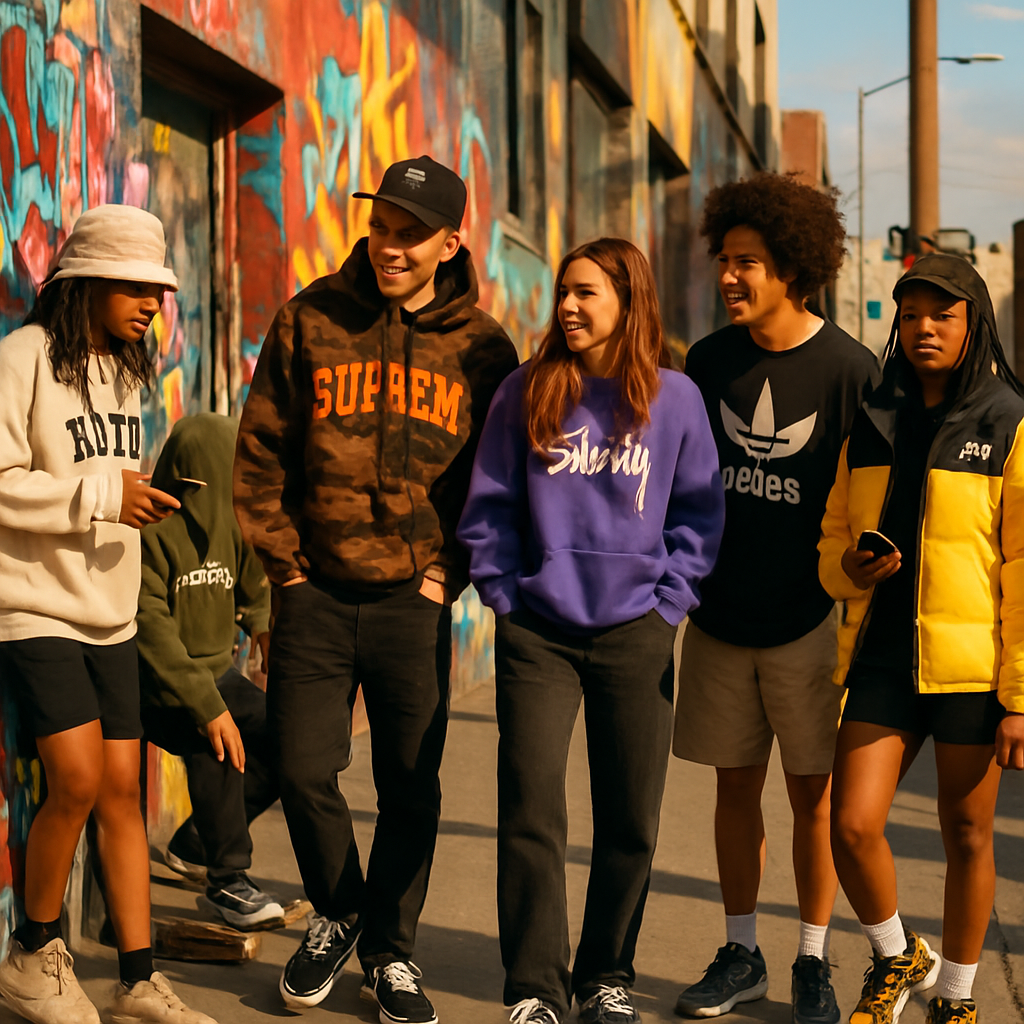
When you think of streetwear, what comes to mind? Maybe it’s the iconic Supreme box logo or the effortlessly cool vibe of a skater weaving through city traffic. It’s a curious fusion of high fashion and urban grit, where sneakers have become more coveted than traditional designer heels, and hoodies can carry a price tag that makes you do a double-take. But how did this once-niche market become a global phenomenon, shaping not only what we wear but also how we think about culture, identity, and even status?
Streetwear’s origins are as eclectic as its designs. Emerging from the skateboarding scene of the 1970s and 80s, this subculture was initially about rebellion. It was a way for skaters and surfers to express themselves outside the confines of mainstream fashion. Fast forward to today, and streetwear is not just a fashion statement it’s a cultural movement. As it turns out, the clothes you throw on before heading out can be a canvas for your beliefs, your background, and even your aspirations.
The Road from Skater Parks to High Fashion
Streetwear’s journey from the fringes to the forefront of fashion wasn’t exactly a straight line. It zigzagged through various youth cultures, picking up bits of hip-hop flair, punk’s raw energy, and even the DIY ethos of graffiti artists. Brands like Stüssy, founded by Shawn Stüssy in the 1980s, tapped into this cultural mosaic. He started by scrawling his signature on surfboards, and before long, that same scribble appeared on T-shirts and hoodies, creating a blueprint for what streetwear could become.
By the 1990s, hip-hop had taken streetwear by storm. Artists like LL Cool J and the members of Wu-Tang Clan wore oversized jeans, graphic tees, and baseball caps, turning these items into symbols of a lifestyle that was both aspirational and attainable. This period signified a turning point. Streetwear wasn’t just about clothes it was about music, art, and an entire way of life. The cultural cachet of streetwear became undeniable.
Now, it’s not just underground brands making waves. Prestige fashion houses like Louis Vuitton and Balenciaga are collaborating with streetwear icons like Virgil Abloh and Demna Gvasalia. When Louis Vuitton appointed Abloh as its men’s artistic director in 2018, it felt like the ultimate validation for streetwear as high fashion. I mean, who would’ve thought that the guy who designed Off-White’s industrial belts would end up at the helm of one of the most storied luxury brands in the world?
The Power of Hype and Community
Ever stayed up late refreshing a webpage hoping to snag a pair of limited-edition sneakers? You’re not alone. The “drop” model, where brands release products in limited quantities, has transformed streetwear into an event. Supreme’s weekly drops have reached cult status, with lines wrapping around city blocks and items selling out in minutes only to appear moments later on resale platforms at jaw-dropping prices.
The scarcity creates hype, and the hype builds community. Owning a piece of streetwear becomes a badge of honor, a way to say, “I’m in the know.” This sense of belonging is palpable at events like Sneaker Con or ComplexCon, where fans gather not just to shop but to connect with like-minded individuals. It’s a bit like being part of a secret club, but one where the door is always open to those who “get it.”
Social media has amplified this phenomenon. Platforms like Instagram and TikTok are modern-day runways where influencers and everyday folks alike showcase their fits. The immediacy of these platforms allows for trends to spread like wildfire, reaching global audiences in a matter of hours. And let’s not forget the rise of resale apps like StockX and GOAT, which have turned sneaker flipping into a legitimate side hustle and in some cases, a full-time career.
But there’s a catch. While the hype can create a sense of community, it can also breed exclusivity. It can feel like if you’re not quick enough or don’t have deep pockets, you’re left out. Maybe it’s just me, but sometimes the whole thing feels a bit frantic. Then again, isn’t that part of the thrill?
A Global Movement with Local Roots
Streetwear has gone global, but at its core, it’s deeply connected to local culture. Whether it’s Tokyo’s Harajuku district, known for its vibrant and eclectic fashion scene, or London’s street markets, where young designers showcase their latest creations, streetwear absorbs and reflects its surroundings.
Take, for example, the influence of Korean streetwear. With brands like Ader Error and Gentle Monster, South Korea has become a hub for innovative and playful designs. The Hallyu wave, driven by K-pop and Korean dramas, has only fueled this growth, making Korean streetwear a staple in closets around the world.
Then there’s the African streetwear scene, which is gaining momentum. Designers like Laduma Ngxokolo of MaXhosa Africa incorporate traditional Xhosa patterns into contemporary designs, creating pieces that are both modern and rooted in heritage. It’s a testament to how streetwear can be a medium for storytelling, allowing designers to share their culture with a global audience.
Streetwear isn’t just about what’s trendy. It’s about making a statement, whether that’s through the message on a T-shirt or the cultural heritage woven into a pair of sneakers. It’s about challenging norms and creating a space where everyone can participate in the conversation, regardless of their background or budget.
The rise of streetwear is a fascinating case study in how fashion can transcend its original purpose, evolving from a simple form of self-expression into a powerful global movement. It’s reshaped the fashion industry, influenced pop culture, and given a voice to those who might otherwise go unheard. And while I used to think that streetwear was just a passing trend, I’m beginning to see it as something much more enduring. It’s a reminder that sometimes the most impactful movements begin in the most unexpected places.
So next time you lace up those limited-edition kicks or throw on your favorite hoodie, consider the stories woven into every stitch. It’s more than just clothing it’s a tapestry of culture, community, and change. And who knows? Maybe one day you’ll find yourself at a streetwear pop-up event, sipping a craft beer, and chatting with a stranger about the latest drop, feeling right at home in a world that’s always in motion.

